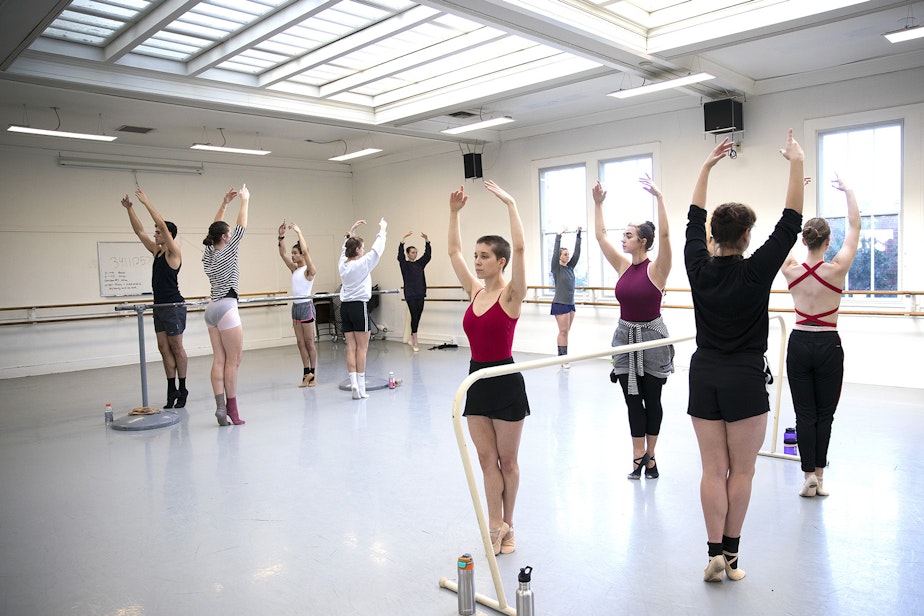After two long years, contemporary dance looks for a comeback

Dance is an intimate art form. When the pandemic hit and in-person interaction dwindled, dancers went in search of what they could do without a practice floor, a stage, or an audience. As venues open again, some want to see a new era of contemporary dance emerge too.
The Yaw Theater is hidden within the industrial landscape of Georgetown. It's (literally) center stage in the Equinox Art Collective, a collection of buildings made out of repurposed shipping containers and converted industrial spaces, which houses a variety of art forms, from gallery artists to metalworkers constructing their next burning-man installation.
"This particular building used to be a woodworking factory," said Stella Kutz, the owner of the Yaw Theater. "There were none of these walls, none of these windows. You can see the vents for the sawdust still in the roof."
The Yaw will be the setting for an upcoming production called "Dance is CRINGE." The production starts outdoors, with dancers clad in red track suits leading the audience through the adjacent alleyway. Then, like pied pipers, the dancers lead the group past the metalworking studio, to the right of the paper-craft studio, and into the Yaw Theater, where they'll encircle the dancers as they move to lasers and leaking fog.
"I just want a little bit of the sweat to fly off the dancers and hit me," said Nathan Langston, who's helping bring the show to Seattle from its home theater in Boise, Idaho. "I want to smell it. I want to be very, very close. I want to be able to see facial expressions."
For everyone involved in the dance world, from producers like Langston to dancers like Kutz, it's been a long two years of social distancing and performing for screens instead of live audiences.
Sponsored
"I don't think that the pandemic hit any art form harder than it hit dance," Langston said. "Musicians obviously were missing playing live, but they could still do their work. They could still release things. For dancers it was apocalyptic, in some ways."
It was in this uncomfortable space where Lauren Edson envisioned "Dance is CRINGE." Her dance company, LED, would publish dance clips and videos online, looking to engage audiences during quarantine. But she kept hearing that word, "cringe."
"I can see how someone who hasn't been a part of that upbringing of dance can feel like dance is reserved for an elite group," Edson said. "Or that it's a little stuffy, a little square. It's hard to relate at times."
The frenetic energy of "Dance is CRINGE," set within its Georgetown backdrop, is part of an effort to recontextualize what contemporary dance can be. It's also a sign of necessity as prices rise in some of the more traditional dance centers of the city.
"Once Capitol Hill priced artists out of of being able to rent a performance space, or a rehearsal space, people started migrating south," said Marcie Sillman, host of the "DoubleXposure" podcast, and a contributing writer to Crosscut. "Some migrated out of the city altogether."
Sponsored
Figuring out how dance can be sustainable is another aspect of "Dance is CRINGE." After coming from Boise to Seattle, the show travels to Portland, Oregon. Franco Nieto, who owns and operates a dance studio called OpenSpace, is hoping the cross-regional collaboration can offer more opportunities for dancers, and better distribute the costs of production.
"We've lost that touring sensibility with dance companies, and maybe that's because we've narrowed our mindset of what a performance opportunity could be," Nieto said, "because we were thinking on a larger scale, of a larger auditorium.
Nieto, Edson, Kutz, and Langston all feel there's an opportunity to move away from table-top theaters and the thousands of seats required to fill them. And the Pacific Northwest, with its rapidly changing makeup and its idyllic backdrops, is the place this change can start.
"We are still seeing that those companies, who have had larger companies and larger audiences before, still fighting for the thing that they had before," Nieto said. "And I think they're missing the mark about, how do we reinvent what dance is as an experience to an audience? How can we make it palatable for the experience?"
"Dance is CRINGE" will be performing Aug. 26 at the Yaw Theater in Georgetown.
Sponsored
You can hear Soundside's full conversation with Marcie Sillman on the history and changing identity of contemporary dance in Seattle by clicking the audio above.






